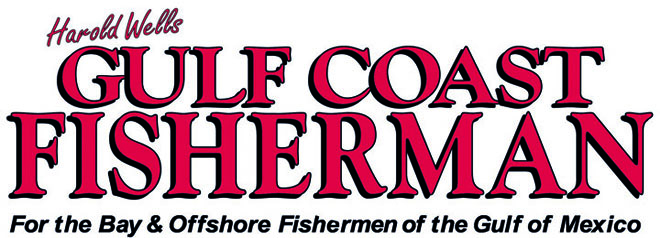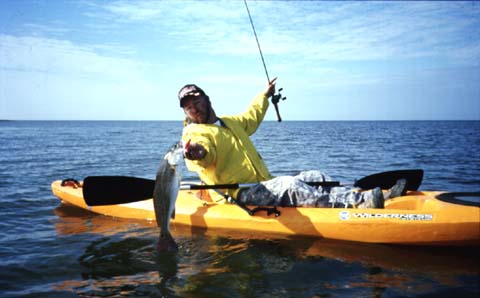
The Saltwater Magazine for Gulf Coast Fishing!
FISHING FORECASTS | ARTICLES | ADVERTISE | SUBSCRIBE
Search Gulf Coast Fisherman's
Web Site
Past articles, specific
places or fish, etc.

KAYAKING
for reds & troutby Robert Sloan
| CURRENT
MOON lunar phases |
- Not too long ago kayaking the coastal bays, marshes and backwater estuaries was something a select few anglers had tapped into. That was then, this is now.
It ain't that way no more. Kayak fishing is the rage along the Texas Gulf Coast, and it's rapidly spreading to other states, as well.
On a recent trip to the Chandeleur Islands, off the Louisiana and Mississippi
coast, I saw a boat with a deck full of kayaks. Talk about the ultimate
escape, try a few days of kayaking at the Chandeleurs.
Kayaking for reds and trout has really taken a firm grip on the middle and lower Texas coast. It's especially popular among fly fishermen.
You might say that Sally Moffett has taken the bull by the horns in regards to kayaking. She's not only a full time kayaking guide and successful fly angler, but owns and operates Rockport Kayak Outfitters, located on the middle Texas coast.
"It sounds pretty romantic, doing what I do," says Moffett. "But in reality it's a lot of hard work, with a whole lot of early wake up calls. However, I wouldn't trade my job for anything. There is nothing better than taking a kayak into a remote flat and finding tailing reds in a foot of water. That's what I call adventure."
Unlike most working folks Moffett turned her back on a big city job in Houston, and headed down the coast to Rockport a few years back. She saw the potential for kayaking and jumped into it head first.
Her specialty is fly fishing from a kayak. And her claim to fame is how she gets anglers from point A to point B. She's got a 24-foot Carolina Skiff that's big enough to hold multiple kayaks. She loads the yaks at the boat ramp, corrals her anglers and heads off to some very isolated flats and estuary lakes. Once on location the yaks are off-loaded and the fishing begins.
That's what I call escape. And it's a part of kayaking that lots of adventure minded anglers are getting a grip on.
The draw is this: With a kayak you don't have to hassle with a boat, motor and trailer. Simply drop it in the water and go. That's it. But the option of loading your kayak into a big rig and covering lots of water is another tactic that's definitely worth checking out.
There are endless areas of the coast that are kayak friendly. On most you can simply drive up, drop your yak into the water and paddle away. That's about as simple as fishing gets.
I was recently at Shoal Grass Lodge in Port Aransas, Texas. It's the only Orvis endorsed lodge on the Texas coast, and is located in South Texas. I met up there with Bobby Caskey, Tim Fading and Terry Upton. After an overnight stay at their comfortable lodge overlooking the bay, we hooked up with Capt. Dean Thomas, who, along with his wife, owns and operates Slowride Guide Services.
Their specialty is guiding anglers to remote areas of the Lighthouse Lakes, a no prop zone, which means you can't run a power boat in the area.
The Lighthouse Lakes span miles upon miles of shallow flats. More than you could ever cover in days in a kayak. This is a mecca for anglers in kayaks.
It offers easy access, marked trails with GPS coordinates, and is a great area to find tailing reds on the flats, and trout in the guts.
Another great kayaking adventure can be found at Port O'Connor, on the middle Texas Coast. This is where you can load your kayak onto the Texas Parks and Wildlife Department's ferry for a shuttle across the bay to Matagorda Island State Park, about 11 miles from the small fishing town.
This island offers well over 20 miles of vodka clear flats on the bay, and also on Pringle Lake. You also have access to Pass Cavallo and the surf. This is an area where you can catch anything from tailing reds to 100-pound plus tarpon.
Primitive camping is available on the island as well as a bunkhouse. (www.tpwd.state.tx.us/park/matagisl/feemata.htm)
By now you're probably getting a feel for the type of adventure you can paddle into with a yak.
Selecting a kayak for your aqua adventures is easy. However, like vehicles and power boats, you will find that there are all sorts of yaks to choose from.
First of all, 99.9 percent of kayaking on the coast is done from sit-on-top models, as opposed to sit-inside yaks. These are wet boats, meaning the seat might take on an inch or so of water. The sit-inside models are dry. But the trade off is that sit-on-top yaks offer easy on and off access.
I've been fishing from yaks for years, and can say from experience that the sit-on-top models are the way to go. They are incredibly stable, a usual concern for yak virgins. A sit-on-top yak is much more stable than a canoe.
One of the most popular and angler friendly sit-on-top yaks on the Texas coast is the Wilderness System Tarpon 140 (a 14-footer). It's also available in a 12-foot length called a Tarpon 120. Another popular angling model is the 12-foot, 6-inch Ocean Drifter.
I've fished from both extensively. The difference between the two is like night and day. However, both are comfortable, with an open deck on the rear and below deck storage on the bow.
The Tarpon 120 and Drifter both weigh about 55 pounds. But the Tarpon 120 is 29.5 inches wide, as compared to the Drifter at 34 inches. The wider Drifter has a weight capacity of 500 pounds. If you are on the heavy side this is the yak for you. The Tarpon 120 has a 300 pound capacity.
The difference is in the ride. Obviously the wider Drifter is going to have more drag on the water's surface. The sleek looking Tarpon is going to glide much easier over the water.
Both models are very comfortable. I've got a bad back and the comfort of these yaks is such that I can easily stay in one all day and not be sore the next.
That's saying a lot.
The really big attraction about kayaking is the cost. You can get into either of the Tarpon 120 or 140 models, and the Drifter for $700 to $1,000, depending on how much you want to spend on outfitting your rig. For example, you'll need padding to sit on, a paddle, rod holder, anchor, a back rest for the Drifter, a PFD, a paddle leash and maybe a rudder and additional hatch kits.
Don't forget a vehicle rack for transporting your yak.
The most surprising thing about kayak angling is the ease of paddling from one location to another. It's not only good exercise, but great stress relief.
There is nothing better than paddling to an isolated flat and wading into trout and reds. Can you say escape?
I'm not a big fan of fishing while seated in a kayak. My idea of fun is paddling to an area and then wading. But at times the only option is to stay in the yak, especially when you are fishing over soft mud and shell, or deep water.
Over the past few years I've seen anglers that turned their noses up at the thought of kayaking for fish. That is until I got them in one. It's as if I've flipped a switch. They go from negative to positive just like that, once they see how comfortable and user friendly they are.
If you have never kayaked my suggestion is to set up with an outfitter and let them guide you for a day or so.
Some of the best kayaking outfitters on the Texas coast include:
· Shoal Grass Lodge, Port Aransas, Texas - (361) 758-5307 or www.shoalgrasslodge.com
· Captain Sally's Reel Fun Charters, Rockport, Texas - (361) 729-9095 or www.captainsally.com
· Lefty Ray's Fly Casting and Guide Service, Port Aransas, Texas - (210) 543-1865 or www.leftyray.com
· Slowride Guide Service, Aransas Pass, Texas - (866) 856-9477 or www.slowrideguide.com.
For all sorts of kayaking information, stories, and fishing reports go to www.texaskayakfisherman.com.
For information on kayak fly fishing trips on East Texas creeks and lakes, email Robert Sloan at sloan288@aol.com

